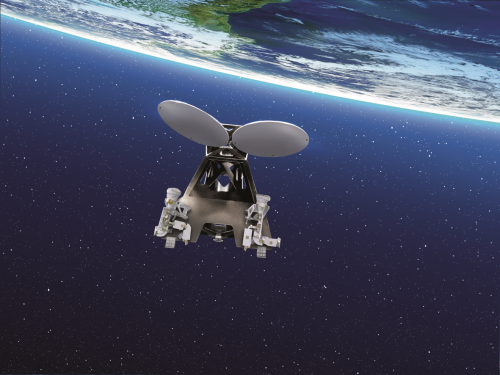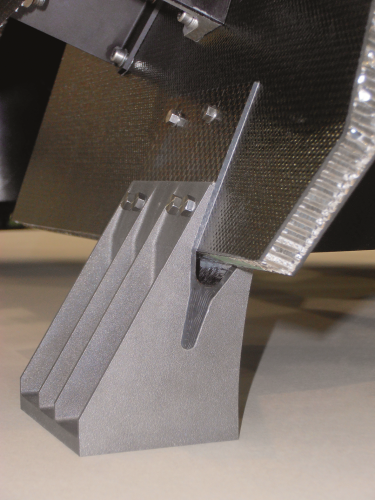

The Airbus Defence and Space division is one of the world‘s leading suppliers of satellite and space transport technology. Its Spanish subsidiary is part of the satellite business and the largest aerospace company in its home market. Its portfolio ranges from satellite systems to components for the International Space Station ISS. A competence centre for composite materials is also located at the headquarters in Madrid. The requirements for the devices are particularly high because of the tremendous temperature differences and external forces involved. To achieve the best results in component manufacturing, Airbus Defence and Space relies, among other things, on AM technology from the German company EOS.
Challenge
The current generation of satellites includes specific brackets that serve as a link between the body of the satellite and the reflectors and feeder facilities mounted at its upper end. The engineers at Airbus Defence and Space faced two key challenges with regards to the construction of these retaining brackets: on the one hand, the brackets must fix the securely to the body. On the other hand, however, the task of the brackets is to mitigate the extreme temperature fluctuations in space. The brackets are very important as a layer of insulation: the temperature ranges from -180 to +150 °C, so the stress on the material is extremely high.
Very few materials are able to meet these requirements. As so often in the aviation and aerospace industry, titanium turned out to be the appropriate choice. In addition to its well-known advantages with regards to weight and thermal conductivity, it offers an acceptable density.
The brackets manufactured in the conventional way and especially their connection with the carbon components of the satellite – a function subject to high thermal stress – did not meet the expectations of Airbus Defence and Space. In addition, subsequent installation on the satellite component was very time-consuming so costs needed to be reduced. The engineers therefore began looking for alternatives. Special attention was paid to the fact that the design of future components could be improved accordingly.
Solution
The choice fell to the AM technology for metal parts offered by EOS. This meant that titanium was still usable as a tried and tested material. It also allowed the design of the components to be adapted easily.
‘The solution now found by us has two advantages,’ said Otilia Castro Matías, who is responsible for the area of antennae at Airbus Defence and Space. ‘For once we were able to optimize production itself. In addition, we have improved the design, so the entire workpiece can be manufactured in a single step.’
After the design was established, the well established process followed: the engineers loaded the 3D construction plans from the CAD software into the production machine – an EOSINT M 280 – and started the manufacturing process: a laser beam precisely melts and hardens the deposited metal powder layer by layer, so when the workpiece is complete, no excess material remains except for re-useable raw material.
Results
The new devices meet all expectations of the experts involved. Most important of all is the improved temperature resistance of the entire structure, which now can easily and permanently withstand a margin of 330 °C under a force of 20 kN. In addition to this, the Spanish aerospace experts were able to reduce production time of the brackets during assembly of feed and sub reflector units by five days. Production time of the three brackets required for each satellite is now less than a month.
‘These improvements significantly reduce thermally induced failure during the qualification test campaign,’ added Castro Matías. ‘The cost of space activities is relatively high, so it is even more important to protect any hardware from possible failures. The AM method brought measurable benefits to critical aspects of the project, without requiring cuts to be made elsewhere.’
In addition to the technical advantages, targeted cost reductions were achieved: savings in production alone amount to more than 20%. What is more, the weight advantage is about 300 g, which means nearly one kilo per satellite.
‘The use of titanium as the material for the retaining brackets of our satellites has proven highly effective,’ said Castro Matías. ‘The main weakness, however, was the connection of the brackets with the carbon panel of feed and reflector assembly because here the thermal stress was negative factor. Thanks to AM, we were able to redesign the bracket and eliminate this vulnerability.’





